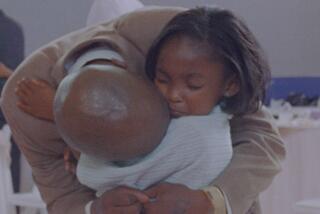Control Panel
- Share via
A high schooler recently accepted an invitation to meet with administrators, teachers and parents who are trying to cut drug use in her school. How, they wanted to know, were drugs coming into the school, and where were they being consumed?
The teen looked her math teacher in the eye. While she had been sitting in his class, second row, she had snorted lines of cocaine off her desk, she replied.
Welcome to the Parent Project, a 9-year-old national effort started by retired Pomona Police Sgt. Ralph Fry. Seeking to re-integrate out-of-control youth back into society, the project consists of a series of classes for parents on how to bring delinquent children in line, coupled with occasional talks by teens, such as the girl who used drugs in class, on what really goes on in their world.
About 15,000 parents spanning all income levels have participated so far. They are about evenly split between one- and two-parent families. Many have enrolled in the project after failing to curb their children’s behavior in other programs, Fry said.
Cited as “program of the year” by the California Youth Authority and “exemplary” by Gov. Pete Wilson, the Parent Project is based on Fry’s 18 years of police work with contributions by psychologist Roger Morgan, California Department of Education consultant Susan Johnson and UCLA Self-Help Support Group Center co-founder Bonnie Burstein. Sliding scale fees for the program, which runs about 12 weeks and has been promoted by police departments and school districts across the country, range from the cost of the materials (about $20) to $150.
Parents attend six three-hour meetings where their eyes are opened to a world in which children and teens make decisions about alcohol, drugs, sex and violence.
The introduction to the youth culture is followed by six support group sessions in which parents discuss their “homework.” One such assignment is to compile a list of the phone numbers and addresses of their children’s friends.
Typical was a recent class held in a Rancho Cucamonga office building. About 20 parents sat in a U-shaped conference room, listening to Morgan describe the look, feel and texture of illicit drugs and possible warning signs that their teen may be using them. Following each half-hour lecture, parents met in groups of two, three and four to discuss their experiences before the main lecture resumed.
Overworked parents manage to spend about 20 minutes a day with their children, Fry said. Within this vacuum, signs of violence, gang affiliations, depression, drug usage and thoughts of suicide are mistaken as phases of normal adolescent rebellion.
The Parent Project tries to help parents get into the minds of their adolescents, letting the child know they love him even as they use short-term rewards and punishments to discipline him.
*
Hard-core kids, Fry explained, have short-term horizons. Thus, talking about long-term consequences of behavior has little effect. A 15-year-old grounded for a few months feels as if he’s received a lifetime sentence. As would any lifer, he sneaks out at the first opportunity, compounding the problem. To be effective, Fry said, a punishment should be limited, allowing the child to see the light at the end of the tunnel.
Similarly, he said, parents should realize they cannot control but only influence their child’s behavior through negotiations. If a child conforms to the parent’s explicit wishes--getting home on time, not using drugs--the parent grants the child the “stuff” he wants--including television and phone privileges. Should the child stray from the bargain, the parent can temporarily lock up the TV or phone, he said.
The program also instructs parents on potential warning signs. While baggy pants with fitted waists are often the social norm, Fry said, baggy pants with overly large waistlines--such as are worn in jails--may signify gang affiliations. Belts with ends reaching down to the knees may not be a fashion statement, but a sign of graffiti tagging. Kids use the belts to shimmy up poles.
Still, Fry stressed, no single sign is evidence of anything. Rather, it should be viewed in the context of the child’s entire behavior.
“It’s a scary world out there today, not at all like the world in which our generation grew up,” Fry said. “But many parents still aren’t aware of how much that world has changed.
Just how much has the youth world changed? Fry provided the most influential sources for adolescent decision-making, as compiled by the Los Angeles District Attorney’s gang prevention unit.
1980: Home. School. Peers. TV. Church.
1990: Peers. TV. School. Home. Church.
Said Fry: “We try to make parents aware of what’s really going on, and how to intervene effectively.”
More to Read
Sign up for Essential California
The most important California stories and recommendations in your inbox every morning.
You may occasionally receive promotional content from the Los Angeles Times.










